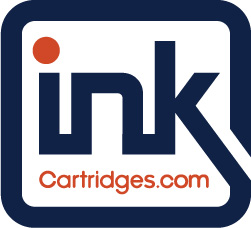Choosing between a printer that uses an ink tank or ink cartridges can be overwhelming. Here is how to make the best buying decision.
Did you know the average ink cartridge consumer will spend nearly as much on their first set of replacement ink cartridges, as what they spent on their printer?
Case in point, the HP® DeskJet® 3755 is a popular low cost option. One high-yield HP DeskJet 3755 black ink cartridge costs $37.99* and one high-yield tri-color cartridge costs $42.99. That’s $80.98 to replace one set of ink for this printer! After buying your second round of replacement cartridges, you’ll have shelled out more on ink than the printer itself.
Ink tank printers are one way you can lower printing costs. Instead of ink cartridges, these printers use ink bottles and a tank system to print, which makes them far more cost effective than your standard inkjet printer.
In this article, we cover the pros and cons of both printer types, so you can make a smart buy.
Quick side note – a common misconception is that an inkjet printer is an ink cartridge printer. When in fact, both ink tank printers and ink cartridge printers are inkjet printers, as they both function the same. Moving forward, we will refer to each respective printer as either ink tank or tank-based, and ink cartridge, or cartridge-based printers.
What is the difference between an ink tank printer and an ink cartridge printer?
Ink tank system printers contain a refillable tank as opposed to empty slots for your ink cartridges. This refillable tank system incorporates the use of ink bottles to fill it up. Ink tanks hold a lot more ink than your standard ink cartridge and are less likely to dry out.
That is because tank-based printer’s continuous ink supply system delivers the ink through an airtight tube to the printhead, so ink will not dry out over time.
As opposed to ink cartridges which already have a built-in printhead and are more likely to dry out if it is not in constant use. Still, both types of printers should be used at least once every couple of weeks to keep the printheads primed so they don’t dry out.
An ink tank printer will cost more upfront. The draw is in its ability to provide a lower cost per page, since refill bottles are significantly less expensive than cartridges.
Ink tanks hold enough ink to print thousands of pages before needing to be refilled. Aside from printing more pages, ink based printers also have a lower cost per page, making them more efficient than cartridge-based printers.
On the flip side, ink cartridge printers are cheaper up front but cost more to operate in the long term due to higher cartridge prices and inefficient page yields.
Ink Tank Printers
Pros
- Replacement ink costs a lot less
- Longer uninterrupted printing – ink does not have to be replaced as often
- Ink tank printers usually come equipped with enough ink to print a couple thousand pages
- More environmentally friendly – less waste from disposed cartridges
Cons
- Initial cost – ink tank printers cost a couple hundred dollars more (when compared to ink cartridge printers with similar features)
- Bulk ink – for those who do not print as often, the excess amount of ink is a waste of money
- Ink tanks can dry out if they are not used regularly
The Bottom Line: Ink tank printers are best for home and office printer users that want to print in color at high volumes for a low cost per page.
Ink Cartridge Printers
Pros
- Ink cartridge printers are generally cheap compared to ink tank printers
- Ink cartridge replacement is pretty straightforward
- Low-cost aftermarket cartridge options are available
Cons
- High printing costs – ink cartridge replacements are expensive therefore increasing the cost per page to print
- Ink cartridges are more likely to dry out when printer is used infrequently
The Bottom Line: Ink cartridge printers are best for occasional home office printer users that want to print in color and do not want to spend a lot of money upfront on a printer.
So, what’s better? Ink tank or ink cartridge?
It depends on how much you plan to print over the next few years. Once you have figured that out, you will want to consider the upfront cost of the ink tank printer versus the ink cartridge printer.
When comparing the initial costs of tank-based printers and cartridge-based printers, make sure they have comparable features.
You will also want to know how much it costs to replace the ink on each respective printer. Also, check the page yields, or the number of pages that can be produced from a tank or cartridge.
From there you can determine your cpp or cost per page. Cost per page is simply the amount of money it costs to print one page. This can be determined with the following equation: cost of ink ÷ page yield = cost per page.
So if your ink tank printer can print up to 2,000 pages per refill, then divide the cost of the ink bottle by 2,000, and you’ll have your cost per page.
For example, an Epson® ET-4760 EcoTank® black ink refill bottle has an average price of $19.99 and yields up to 7500 pages. $19.99/7500 pages = nearly 1/4th of a penny per page.
Similarly, if you divide the price of the ink cartridge by its page yield, you will get the cost per page for the ink cartridge printer. From there you can determine which printer will cost you more overall, and whether an ink tank printer is worth investing in. In almost all cases, ink tank printers will offer a lower cost per page compared to an ink cartridge printer.
Other ways to save
If you are looking to lower your printing costs even more, aftermarket ink is a great way to save. Here at InkCartridges.com, we offer cost-effective compatible ink for almost every popular ink tank and ink cartridge printer on the market. See how much you can save at inkcartridges.com.
Conclusion
To sum it up, ink tank printers cost more upfront but cost less to operate and are better suited for high-frequency print users. Ink cartridge printers are cheaper but cartridge replacements are not. So low-frequency print users may still find the latter a better option.
Overall, printer users need to compare the printer price, printer features, cartridge price, cost per page and weigh their printing needs to make the best decision.
Now that you know the difference between an ink tank printer and an ink cartridge printer, as well as their pros and cons, you can make an informed decision between the two.
If this guide to choosing between an ink tank printer and an ink cartridge printer has helped you let us know in the comments below. And don’t forget to mention which printer type you’ve decided on and why!
*Savings based on price comparison between remanufactured/compatible cartridge prices on inkcartridges.com and OEM cartridge and printer prices from the listed retailers: Best Buy, Staples. All products are reviewed independently. All prices effective as of September 12, 2022. OEM names are registered trademarks of their respective owners and are not affiliated with, and do not endorse inkcartridges.com.



